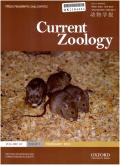Ecology and social behavior of the tamarisk gerbil Meriones tamariscinus: Insights from long-term research in the wild and seminatural environments
IF 2
2区 生物学
Q2 ZOOLOGY
引用次数: 0
Abstract
The present review provides a compilation of the published data on the ecology and social behaviour of tamarisk gerbils. Both field studies and direct observations under semi-natural conditions provide evidence that the tamarisk gerbil is a nocturnal herbivorous rodent that lives in highly seasonal habitats and displays seasonal fluctuations in reproduction and spatial organization. A typical feature of the tamarisk gerbils' spatial organization is higher mobility of males during the breeding season (as compared to the non-breeding period) and formation of temporary aggregations of males competing for access to receptive females; the composition of these aggregations was variable and depended on the reproductive condition of the females. Females tend to occupy exclusive home ranges irrespective of their reproductive condition. The mating system of the species can be defined as scramble competition polygyny with some features of polygynandry and promiscuity. The tamarisk gerbil has distinct features of a solitary species and its social structure is primarily based on aggressive interactions or mutual avoidance of conspecifics resulting in a dominance hierarchy among males and site-dependent dominance among females during the breeding season. By the end of the breeding season, males become less mobile and occupy nearly exclusive home ranges, consistent with solitary living. The main features of the spatial and social organization of this species, which distinguish it from other solitary rodents, are the higher mobility of males and the formation of temporary multi-male–multi-female aggregations during the breeding season. Overall, the data presented expand our understanding of socio-ecology of gerbils.柽柳沙鼠(Meriones tamariscinus)的生态学和社会行为:野外和半自然环境中长期研究的启示
本综述汇编了已发表的有关柽柳沙鼠生态学和社会行为的数据。野外研究和半自然条件下的直接观察都证明,柽柳沙鼠是一种夜行性食草啮齿类动物,生活在季节性很强的栖息地,其繁殖和空间组织表现出季节性波动。柽柳沙鼠空间组织的一个典型特征是雄鼠在繁殖季节(与非繁殖季节相比)的流动性较高,并形成雄鼠的临时聚集,争相接近有受精能力的雌鼠;这些聚集的组成是多变的,取决于雌鼠的繁殖状况。无论繁殖状况如何,雌性都倾向于占据独占的家庭范围。该物种的交配系统可定义为争夺性竞争多配偶制,并具有多配偶制和滥交的一些特征。柽柳沙鼠具有明显的独居物种特征,其社会结构主要基于攻击性互动或相互回避同类,从而在繁殖季节形成雄性之间的优势等级和雌性之间的地点优势。到了繁殖季节末期,雄性的活动能力会降低,占据的家域几乎是独占的,这与独居生活是一致的。该物种的空间和社会组织有别于其他独居啮齿类动物,其主要特征是雄性的较高流动性以及在繁殖季节形成临时的多雄多雌聚居。总之,所提供的数据拓展了我们对沙鼠社会生态学的理解。
本文章由计算机程序翻译,如有差异,请以英文原文为准。
求助全文
约1分钟内获得全文
求助全文
来源期刊

Current Zoology
Agricultural and Biological Sciences-Animal Science and Zoology
CiteScore
3.20
自引率
9.10%
发文量
111
审稿时长
6 weeks
期刊介绍:
About the Journal
Current Zoology (formerly Acta Zoologica Sinica, founded in 1935) is an open access, bimonthly, peer-reviewed international journal of zoology. It publishes review articles and research papers in the fields of ecology, evolution and behaviour.
Current Zoology is sponsored by Institute of Zoology, Chinese Academy of Sciences, along with the China Zoological Society.
 求助内容:
求助内容: 应助结果提醒方式:
应助结果提醒方式:


